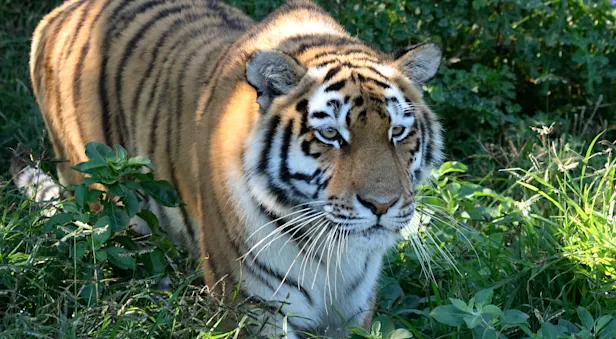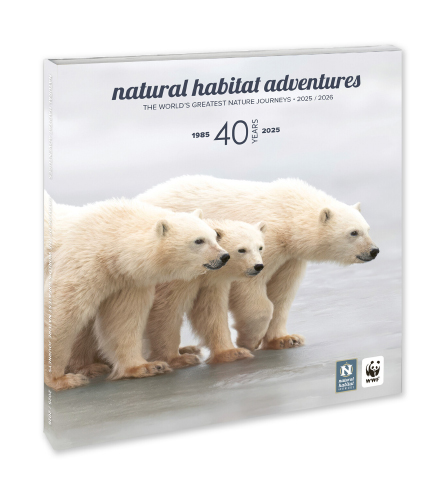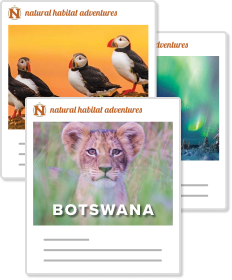Know Before You Go
India Packing List | Winter & Early Spring
The following packing list contains general recommendations for an India wildlife safari in the cooler winter and early spring months (November through April). If you are currently booked on the Grand India Wildlife Adventure with Nat Hab, please consult your pre-departure materials for the most up-to-date packing list for your trip. You will receive these pre-departure materials 60–90 days before your departure.
Items indicated in color below are typically available in the Nat Hab Gear Store. Please note that due to global supply chain issues beyond our control, we cannot guarantee that every item will always be in stock.
Adventure Guidelines
It can be quite cold in northern India from November to January, with temperatures dropping into the upper 30s Fahrenheit at night and early mornings. During the day it can reach the 80s Fahrenheit, but if you are not in the sun, it can still feel cool. Temperatures start to warm up in February and March, but the early mornings will still be chilly.
Plan to dress in 2–3 layers, including a warm hat, gloves, scarf, long pants, potentially long underwear, and a warm down jacket, especially while on wildlife drives. From November to January you may wear all these items throughout the day, while in February and March you will be more likely to wear them in the mornings and shed layers as it warms up throughout the day.
Wildlife drives can be extremely dusty at this time of year. We recommend bringing a dust-proof bag to protect your photo equipment during outings and eye drops if you are sensitive to dust.
We encourage you to take into account local attitudes toward modesty and propriety. Your style of dress will, in part, determine your acceptance by, and interaction with, local people. Always check with your guide concerning proper dress code for the day’s activities.
While you may see other tourists wearing these items, in general, shorts and tank tops (clothing that reveals your knees and shoulders) are considered disrespectful and are not culturally appropriate while in Delhi. This is especially true for women.
Wearing modest clothing is especially important in temples and monasteries. Shorts or other revealing items should never be worn.
It is acceptable, however, to wear shorts during wildlife drives while in the national parks.
In mosques you will be requested to cover your head.
Clothing
Silk, wool or polypropylene long underwear for layering (tops & bottoms)
Lightweight neck gaiter (included in your pre-departure package)
—Provides sun, wind and/or dust protection.Rain gear
— Although our adventure takes place in the winter after monsoon season has ended it is possible to encounter inclement weather. We recommend bringing durable, lightweight, fully waterproof (not just water-resistant) rain gear, including a jacket with hood and rain pants.Lightweight down jacket
— This is especially important on trips beginning November through January.Warm, windproof fleece
— One that can be layered under your jacket is ideal.Sturdy walking shoes / sport sandals
— Bring comfortable shoes that are appropriate for walks and wildlife drives. They should be broken in to prevent blisters.
— Closed-toe shoes are recommended for cooler months.Hat, scarf and gloves
— Good to have for cold morning and evening wildlife drives.3–4 short-sleeved shirts
— Bring modest shirts that cover your shoulders. Although it is not required, it is respectful to wear a shirt with a collar when visiting temples and monasteries.2 pairs of long pants
Light sweater
Long skirt for women (optional)
Long underwear (top and bottom)
— Good to have for early morning wildlife drives if you get cold easily. This is especially handy for trips from November to January.Extra pair of comfortable shoes
— To wear in the evenings after outdoor excursions.Socks
— Bring socks made of wool or other moisture-wicking material; cotton socks are not recommended for longer walks.
— As you will need to remove your shoes while visiting temples and monasteries, and floors in these public places tend to be cold and very dirty, you may also wish to bring an old pair of socks you can wear during these outings and throw away after the adventure.Undergarments
Sleepwear
Swimsuit (Optional)
Slippers
— Optional—floors in the hotels and lodges can be cold.
Additional Items
Cash
— For discretionary gratuities (you may want to bring envelopes for discreet presentation)
— For personal spending (souvenirs, Internet use and food and beverages not included in your trip fee)
— Video camera fees (if applicable)Binoculars
— Binoculars are a huge asset for wildlife viewing and are highly recommended. For optimal viewing, we suggest those with specs between 10x42 and 8x42. You may even try 8x35 but only if they contain high-quality glass. Practice using your binoculars before your adventure to make sure they are not too powerful or you do not have trouble holding them steady.Water/dust-resistant daypack
— To carry camera equipment or other gear during outings.
— A dust-proof drawstring bag will also be helpful to protect your equipment when traveling in open 4x4s on wildlife drives.Headlamp or small flashlight
— Power outages are not uncommon. Carry spare batteries.
Sun hat (with wide brim for protection)
— A good option is one that also has a “skirt” to cover your neck.Reusable water bottle (included in your pre-trip package)
—In our continuing effort to operate our adventures with as little impact on the environment as possible, you will receive a reusable water bottle (unless you opted out on your Booking Form) to take with you on your adventure. We will provide drinking water throughout the adventure for you to refill your bottle. By doing this, you will avoid using multiple disposable plastic bottles.Small, compact umbrella
Sunglasses (with UV protection)
Prescription glasses/contact lenses
Battery-operated alarm clock or wristwatch
Earplugs
Toiletries
— Shampoo, conditioner, soap and lotion are provided at all accommodations.Quick-drying washcloth
— You may wish to bring a washcloth if you prefer to use them, as they may not be provided by all accommodations.Toilet paper
— As toilet paper is not always available in public restrooms, you may want to keep a roll in your daypack. Take out the center roll for easier packing.Insect repellent and anti-itch ointment
— Repellents containing DEET are the most effective against mosquitoes, but please be aware that DEET is a very strong ingredient that can damage plastics, clothing and equipment.Sunscreen and lip balm (at least SPF30)
Electrolyte/flavor crystal packets (optional)
— Can be added to water to replace fluids in case of intestinal illness and/or enhance the taste to encourage hydration.Melatonin
— To help ease effects of jet lag.Anti-bacterial gel or towelettes
Small calculator (for currency conversion)
Dry bags or reusable waterproof bags
— Great for wet or dirty clothing and to protect camera equipment from the elements.Hairdryers are provided at all accommodations.

























